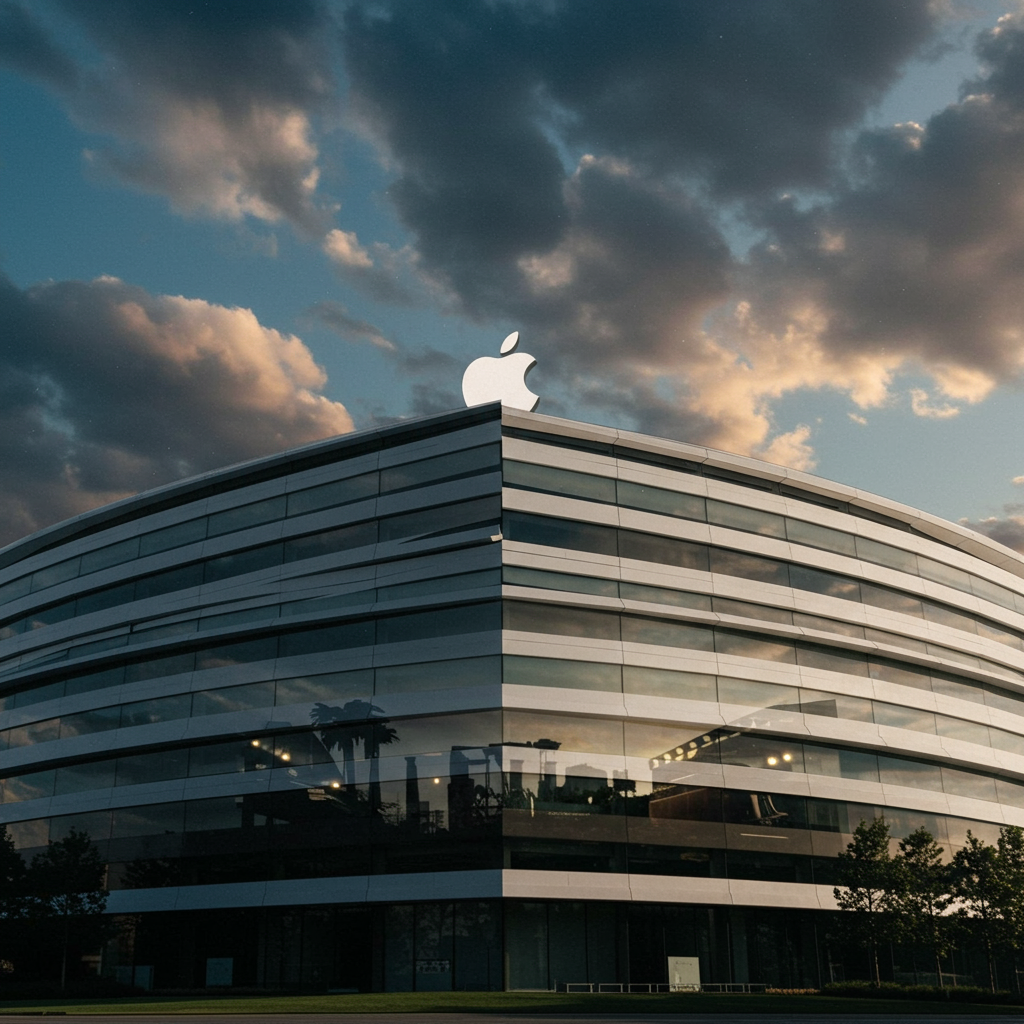Champagne flowed at apple‘s headquarters recently, perhaps mirroring the celebratory mood of a Formula One victor. The reason? “F1,” the big-budget racing drama, delivered Apple Studios its first genuine box office hit. This success marks a critical turning point for the tech giant’s evolving movie ambitions, prompting questions about its future direction in Hollywood.
After years of significant investment and mixed theatrical results, “F1″‘s strong performance offers a much-needed win. The film, starring Brad Pitt as a veteran driver returning to the sport, resonated with audiences worldwide. Its opening weekend generated an estimated $146.3 million globally, including a robust $57 million domestically. while the production cost hovered around $250 million, necessitating continued strong ticket sales for theatrical profitability, these initial numbers are highly encouraging for an original film targeting adult viewers.
Why ‘F1’ Was Crucial for Apple
Apple’s journey in the film business over the past six years has been marked by both prestige projects and commercial disappointments. While celebrated films like Martin Scorsese’s costly “Killers of the Flower Moon” and Ridley Scott’s expensive “Napoleon” garnered critical attention, their financial returns were underwhelming. Other releases, including “Fly Me to the Moon” and “Argylle,” were outright flops, struggling to reach profitability or critical acclaim. This string of underperformers created internal pressure.
There was a growing sense that if a broad-appeal movie like “F1” couldn’t succeed in theaters, Apple might need to reconsider its theatrical ambitions. Some speculated the company could pivot entirely to its successful television division, home to hits like “Severance” and “Ted Lasso.” While no single film dictates Apple’s entire future, insiders suggest “F1″‘s momentum provides a compelling reason for Apple to maintain its course in the theatrical space.
David A. Gross, who leads the FranchiseRe movie consulting firm, noted that “F1” appears to embody the “successful business model Apple has envisioned and wanted to execute for several years.” The film’s integration with the real-world sport, unique production methods filming at actual F1 races, and focus on spectacle align with potential strategies for future success.
Apple’s Ambitions Meet Reality
Apple had previously pledged to spend $1 billion annually on theatrical films starting in 2023. However, the actual output has been notably sparse. Following Spike Lee’s “Highest 2 Lowest,” scheduled for a limited two-week theatrical run through A24 in August, Apple currently has no other major releases slated for 2025 or 2026. Several films are in production or development, including an action-adventure starring Ryan Reynolds called “Mayday” and a UFO feature reuniting “F1” director Joseph Kosinski and producer Jerry Bruckheimer. Reports also indicate that gears are turning on a potential “F1” sequel.
Despite the limited slate, the success of “F1” raises key questions. Will this embolden Apple to accelerate its theatrical plans and build a more robust film calendar? Or, given the complex, multi-year journey to bring “F1” to the screen, will Apple choose a more measured approach, taking only select, high-profile swings with the right projects and talent?
The path forward for Apple’s film strategy remains somewhat open. Here are four potential directions the studio could take in the wake of “F1″‘s success.
Four Potential Paths for Apple’s Film Strategy
Apple’s future moves in the film world will likely fall into one of these categories, each presenting distinct advantages and risks.
Path 1: Going Full Throttle into Theatrical Distribution
One ambitious route involves Apple fully committing to big-screen releases, aiming for a slate comparable to Amazon MGM’s plan of releasing a dozen or more films annually. This path would require Apple to build its own global distribution infrastructure. This is a massive undertaking, realistic only if Apple planned a substantial and consistent slate. Even for a company with Apple’s financial resources, establishing distribution offices and staff worldwide for only a few movies a year wouldn’t be practical.
Advantages: Apple would gain complete control over every aspect of distribution, from marketing campaigns to booking theaters globally. Theatrical hits could potentially create a “halo effect,” driving subscriptions to Apple TV+ and boosting sales of hardware like iPhones and Macs.
Risks: Building a major global distribution network is incredibly difficult and expensive; few companies successfully maintain this scale. Existing studios like Disney and Warner Bros. employ thousands globally for this purpose. While cost isn’t the primary barrier for Apple, reckless spending doesn’t align with their usual approach. Relying solely on internal distribution also exposes Apple directly to box office scrutiny, potentially tarnishing its carefully guarded reputation if films fail.
Likelihood: Not very likely in the immediate future due to the scale and complexity required.
Path 2: Continuing Opportunistic, High-Profile Projects
This strategy sees Apple continuing to act as a financier for select, high-profile projects. The company could cherry-pick films, partnering only with top-tier directors and major stars on projects meeting specific criteria. Apple has shown a willingness to be the highest bidder for talent. These films could align with Apple’s brand values or even showcase its technology, as “F1” reportedly did by utilizing camera tech found in iPhones during production.
Advantages: Apple avoids the immense investment required for building a distribution arm. By being highly selective, Apple minimizes association with financial flops, protecting its sterling reputation. This aligns with CEO Tim Cook’s description of Apple as a “toolmaker,” empowering creators.
Risks: This path relies heavily on external studio partners (like Warner Bros., Sony, or Universal) for theatrical distribution. These partners are compensated with a small percentage (often 7-12%) of global gross. However, they often share significant upfront marketing costs with Apple ($50 million to $75 million per film). When films underperform, the distribution partners lose money. Since Apple’s films go exclusively to Apple TV+ after theaters, there’s no downstream streaming benefit for these partners. This dynamic could strain relationships over time, making partners less willing to distribute future Apple films.
Likelihood: Very likely, at least in the short term, as it mirrors Apple’s current operational model.
Path 3: Fully Embracing a Streaming-First Model
Adopting a model similar to Netflix, Apple could prioritize streaming releases for most films. Theatrical runs might be limited to qualifying for awards consideration in select theaters for a few weeks. Apple has already won a Best Picture Oscar (“CODA”) with a film primarily seen on Apple TV+, demonstrating the viability of this approach for prestige projects.
Advantages: Apple avoids the public scrutiny and potential embarrassment of box office failures. The company could spend heavily to attract talent without worrying about the financial outcome being publicly dissected. This aligns with Apple’s general secrecy around Apple TV+ metrics, which are buried within broader “Services” revenue.
Risks: Many prominent filmmakers, including figures like Christopher Nolan and Greta Gerwig, highly value traditional, wide theatrical releases. Abandoning this could alienate top talent. It also removes a key differentiator between Apple TV+ and Netflix. Furthermore, most theater owners prefer partners committed to longer, wider releases and may refuse to screen Apple’s films. Crucially, streaming-only releases risk fading into obscurity; films like “F1” generate much more buzz and discussion than many direct-to-streaming titles.
Likelihood: Probably not, particularly if Apple wants to attract and work with major directors who prioritize the big screen experience.
Path 4: Acquiring a Hollywood Studio
With billions in cash reserves, Apple certainly has the capacity to purchase an existing studio or entertainment library. While speculation about acquiring a giant like Disney has surfaced, other companies like Lionsgate or Warner Bros. might be more accessible or willing sellers.
Advantages: A major acquisition would instantly provide Apple with a wealth of intellectual property, established production and distribution infrastructure, and experienced talent. Owning extensive film libraries also offers a consistent revenue stream through licensing older titles.
Risks: CEO Tim Cook has expressed a preference against large acquisitions, stating it doesn’t feel “like Apple” and that the company prefers to “pour our passion into” building organically. Furthermore, buying an established studio means inheriting existing complexities, outdated processes, and potential organizational burdens common in legacy Hollywood.
Likelihood: Depends heavily on finding the right cultural and strategic fit, and whether Apple deviates from Cook’s stated preference against large-scale M&A.
The Unique Production Story of ‘F1’
The success of “F1” is intertwined with its unique production approach, highlighting Apple’s willingness to invest in innovative filmmaking. Directed by Joseph Kosinski, fresh off “Top Gun: Maverick,” the film aimed for unprecedented authenticity in depicting Formula One. Gaining access to the highly secretive world of F1 required extensive cooperation from the sport’s governing body, teams, and drivers.
Filming occurred at actual Grand Prix race weekends worldwide, a complex logistical feat. The production utilized converted Formula Two cars modified to resemble F1 vehicles, shooting action sequences between official sessions. Special cameras were mounted extensively – sometimes up to 15 per car – to capture dynamic cockpit footage of Brad Pitt and co-star Damson Idris, who learned to drive at speeds up to 180 mph. Both actors reportedly drove the cars themselves during filming, a detail confirmed by Apple executives.
Seven-time F1 champion Lewis Hamilton served as a producer and advisor, ensuring technical accuracy. F1 CEO Stefano Domenicali and Mercedes team principal Toto Wolff were also executive producers, granting access previously unheard of in the sport. Filming moments like a fake podium celebration after the real race in Abu Dhabi integrated the film seamlessly into the F1 environment, generating significant buzz among fans long before release. The substantial budget was partially offset by sponsorships from companies like Expensify and Mercedes-Benz, further demonstrating the collaborative nature of the project.
What Lies Ahead?
“F1″‘s box office win is a significant milestone, validating Apple’s ability to produce and market films capable of performing on the big screen, even when facing tough competition from established summer tentpoles. It provides much-needed positive momentum after a series of theatrical struggles. While the film’s ultimate profitability journey is just beginning, its opening performance offers a blueprint for success Apple has sought.
The strategic implications are clear: Apple now has tangible evidence that original, high-budget, star-driven films can work theatrically under its banner. This doesn’t guarantee a full pivot to building a major distribution arm, but it does provide a strong argument against abandoning theatrical releases altogether. The most probable path forward appears to be a continuation of its opportunistic approach – funding ambitious, high-profile films that resonate with its brand and potentially its technology, while continuing to rely on traditional studio partners for distribution.
However, the viability of relying on distribution partners who share significant costs without gaining downstream streaming benefits remains a long-term question. Apple’s future actions, particularly its upcoming release slate and how it navigates these partnerships, will reveal how “F1″‘s success truly shapes its place in the ever-evolving landscape of Hollywood.
Frequently Asked Questions
What was the box office performance of Apple’s ‘F1’ movie?
Apple’s film “F1” had a successful opening weekend, generating an estimated $146.3 million globally. This included $57 million earned in domestic theaters within the United States and Canada. While the film had a large production budget of around $250 million, these initial ticket sales were seen as a strong start and a crucial box office hit for Apple Studios.
How does Apple typically distribute its movies theatrically?
Apple Studios does not currently have its own global distribution network. Instead, for its theatrical releases, Apple partners with established Hollywood studios like Warner Bros. (for “F1”), Sony (“Napoleon,” “Fly Me to the Moon”), Paramount (“Killers of the Flower Moon”), and Universal (“Argylle”). These partner studios handle putting Apple’s films into theaters worldwide, often sharing upfront marketing costs with Apple.
Will Apple acquire a major Hollywood studio in the future?
While Apple has significant cash reserves and the financial capacity to acquire a studio like Lionsgate or even larger entities, it has historically avoided such major acquisitions. Apple CEO Tim Cook has indicated that this approach doesn’t align with the company’s ethos, preferring to build businesses organically. Therefore, while financially possible, acquiring a major studio is considered less likely in the immediate future compared to other strategic options.
References
- variety.com
- <a href="https://www.imdb.com/es/news/ni65359214/?ref=nwcart_perm”>www.imdb.com
- <a href="https://www.imdb.com/es/news/ni65359138/?ref=ttnwr_1″>www.imdb.com
- www.thewrap.com
- time.com



